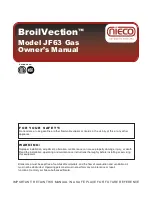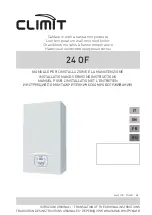
62
106375-01 - 4/16
VII. Venting
H. Assembly of Centrotherm InnoFlue Vent Systems
6. Installations using InnoFlue Flex (Vent Options 20,21,37,38):
WARNING
Asphyxiation Hazard. When using InnoFlue Flex, observe the following precautions:
• InnoFlue Flex may be damaged by handling at low temperatures. Do not bend, uncoil or attempt to
install if it has been stored at a temperature below 42°F without allowing it to warm to a higher
temperature first.
• Do not bend InnoFlue Flex more than 45°.
• Instructions below reference the Centrotherm InnoFlue instruction manual. Not all vent configurations
shown in the Centrotherm manual are approved for use with this boiler.
Refer to Centrotherm InnoFlue Instructions for assembly of all flex components including the chimney cap and the adaptor
to rigid InnoFlue at the base of the masonry or B vent chimney. In addition, observe the following requirements:
a. Refer to the appropriate Vent option in Tables 7.13b or 7.21 for a list of the principle flex components required. Rigid
vent pipe by the same manufacturer will also be required for the run from the boiler to the base of chimney.
b. Masonry chimneys cannot be used for an air chase
c. B vent chimneys can only be used for an air chase (Vent options 20, 21) if the B vent has the minimum size shown in
Table 7.13b and is fully accessible for sealing of all joints and seams.
d. When Vent Options 20, 21 are used, install a Tee of the same size at the base of the vent. Route the smooth section of
InnoFlue Flex (3") or Flex Adaptor (2") through a cap in the base of this Tee. Use a Centrotherm IAWP2P or IAWP03B
wall plate and RTV to seal this penetration. Install the Base Support using the Base support bracket as described in the
InnoFlue installation manual.
Connection of the PVC air intake pipe to the side outlet of the tee is made using a cap and a PVC socket x male thread
adaptor (2" or 3", depending on the Vent Option). Cut a clearance hole in the cap for the male threads. Secure the adaptor
to the cap using a 2" or 3" electrical conduit lock nut. Seal all joints with RTV.
I. Condensate Trap and Drain Line
All condensate which forms in the boiler or vent system passes through the heat exchanger and out of a bottom drain port
which is connected to the field-installed condensate trap. This trap allows condensate to drain from the heat exchanger while
retaining flue gases in the boiler. This trap is an integral part of the boiler but must be connected to a drain pipe as shown in
Figure 7.46
.
A length of corrugated tubing is supplied with the boiler and is connected to the trap as shown in Figure 7.46. Note
the following when disposing of the condensate:
1. Attach condensate trap to heat exchanger condensate drain. Slide inlet nut followed by inlet gasket onto heat exchanger
drain. Then tighten inlet nut onto trap body. Nut and gasket must be secure to create a seal.
2. Attach condensate trap bracket to bottom of boiler using provided screws.
3. Ensure vent plug is removed from trap to improve condensate drainage.
4. If the corrugated condensate drain line must be extended, construct the extension from PVC or CPVC pipe.
Insert the hose
provided with the boiler into the end of the extension as shown in Figure 7.46.
5. Condensate is slightly acidic. Do not use metallic pipe or fittings in the condensate drain line. Do not route the drain line
through areas that could be damaged by leaking condensate.
6. Some jurisdictions may require that the condensate be neutralized before being disposed of. Dispose of condensate in
accordance with local codes.
7. Do not route, or terminate, the condensate drain line in areas subjected to freezing temperatures.
















































